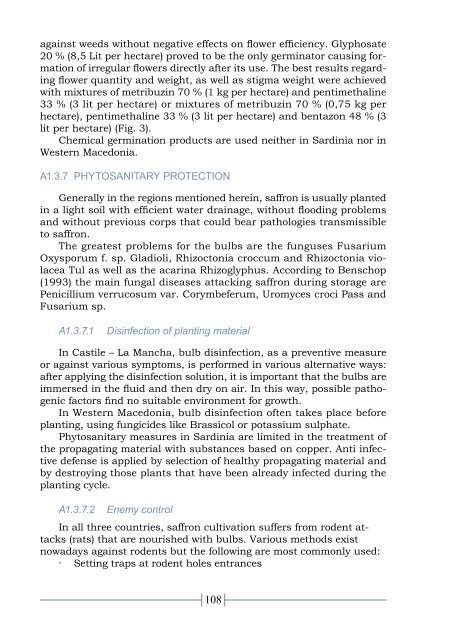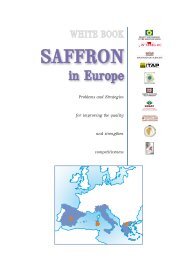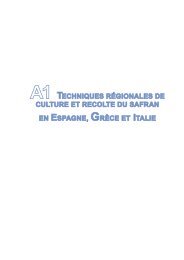Annex White book.pdf
Annex White book.pdf
Annex White book.pdf
You also want an ePaper? Increase the reach of your titles
YUMPU automatically turns print PDFs into web optimized ePapers that Google loves.
against weeds without negative effects on flower efficiency. Glyphosate20 % (8,5 Lit per hectare) proved to be the only germinator causing formationof irregular flowers directly after its use. The best results regardingflower quantity and weight, as well as stigma weight were achievedwith mixtures of metribuzin 70 % (1 kg per hectare) and pentimethaline33 % (3 lit per hectare) or mixtures of metribuzin 70 % (0,75 kg perhectare), pentimethaline 33 % (3 lit per hectare) and bentazon 48 % (3lit per hectare) (Fig. 3).Chemical germination products are used neither in Sardinia nor inWestern Macedonia.A1.3.7 Phytosanitary protectionGenerally in the regions mentioned herein, saffron is usually plantedin a light soil with efficient water drainage, without flooding problemsand without previous corps that could bear pathologies transmissibleto saffron.The greatest problems for the bulbs are the funguses FusariumOxysporum f. sp. Gladioli, Rhizoctonia croccum and Rhizoctonia violaceaTul as well as the acarina Rhizoglyphus. According to Benschop(1993) the main fungal diseases attacking saffron during storage arePenicillium verrucosum var. Corymbeferum, Uromyces croci Pass andFusarium sp.A1.3.7.1Disinfection of planting materialIn Castile – La Mancha, bulb disinfection, as a preventive measureor against various symptoms, is performed in various alternative ways:after applying the disinfection solution, it is important that the bulbs areimmersed in the fluid and then dry on air. In this way, possible pathogenicfactors find no suitable environment for growth.In Western Macedonia, bulb disinfection often takes place beforeplanting, using fungicides like Brassicol or potassium sulphate.Phytosanitary measures in Sardinia are limited in the treatment ofthe propagating material with substances based on copper. Anti infectivedefense is applied by selection of healthy propagating material andby destroying those plants that have been already infected during theplanting cycle.A1.3.7.2Enemy controlIn all three countries, saffron cultivation suffers from rodent attacks(rats) that are nourished with bulbs. Various methods existnowadays against rodents but the following are most commonly used:· Setting traps at rodent holes entrances108




